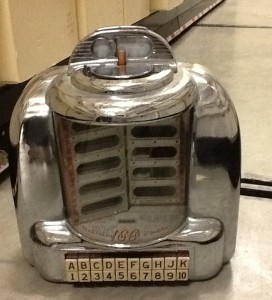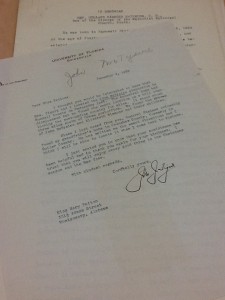By: Mary Haney, University of Alabama MLIS student
This post is part of an ongoing feature of all graduate students, faculty, and staff working in the Division of Special Collections at the University of Alabama. Read more about three of our previous students: Ellie Campbell, Alex Goolsby, and Haley Aaron. Or check out profiles of Kevin Ray and Tom Land. Kevin is the Archival Technician who supports reference services and Tom, prior to his retirement, managed the University Archives.
First off, how did you get started in this field?
My first library job was working as a student page in the Special Collections at Hugh M. Morris Library at the University of Delaware. I had recently declared a major in the University’s undergraduate program in Art Conservation and sought out my academic advisor for advice on how to gain more experience in the field. When I mentioned my interest in book and paper conservation, my advisor immediately set me up with an interview for a page position in special collections. While the position did not offer direct experience in conservation, it afforded me the opportunity to work with and learn about the objects that drew my interests. By working closely with the knowledgeable and supportive staff, I learned more and more about rare books and collections management. One librarian often pulled me aside to show me incunabula he found in the stacks, noting peculiar binding materials or marginalia. The archivists would talk to me about ethical issues in archives. Steadily, I began to realize that my interest in books and papers related more to how people used the materials and what they learned from them rather than their physical properties. By the end of my senior year, I strongly considered pursuing a degree in Library and Information Studies instead of continuing on to an advanced degree in Art Conservation.
After undergraduate graduation, I decided to take a year off to work and decide my next move. I ended up volunteering at Hagley Museum and Library in Wilmington, DE a couple days a week. At first, I assisted with an inventory of the museum’s collections, but was put in contact with the paper conservators in the library after discussing my work history. There, I got to see how conservators handle conservation concerns with frequently used materials. I completed simple conservation projects, such as creating custom-sized boxes for books and removing labels and harmful adhesives from new acquisitions. Again, by working with such helpful professionals, I gained enough experience to have a solid knowledge base for working with library materials. But still, I found myself drawn to the reference and circulation aspects of the library. So I ran with those thoughts and applied for library school.
Once I arrived at the University of Alabama to begin my coursework in Library and Information studies, I was fortunate enough to be awarded a Graduate Student Assistant position at Hoole Special Collections. During my assistantship, I conducted an inventory of the manuscripts collection. This has been excellent experience in data entry and working with databases, two skills I desperately needed to cultivate. I have been lucky to work with yet another group of library professionals who are so willing to help me figure things out and explain how different programs work. This position had also been super helpful in acquainting me with the state of Alabama. It’s a little disorienting to move to a new place with little knowledge of the area, but now I feel like I know a little bit about everything regarding Alabama just by working so closely with the collections.
What is the most surprising item you’ve seen during your time in the stacks at Hoole?
For the majority of my time as a graduate student assistant at Hoole, I completed an inventory of the manuscripts collection. For the most part, this meant noting the size and location of boxes and ledgers. But one day, as I shifted through the stacks, I came across something I could only think of as a large metal thing. After some research, I found that the chrome mystery object was actually a juke box belonging to the James Salem collection. James Salem was a professor and American Studies department chair at the University of Alabama. His work focused on American culture and music, as evidenced by his most notable publication entitled The Late Great Johnny Ace and the Transition from R & B to Rock ‘N’ Roll. Thus, the juke box mixed up in a collection comprised predominantly of rare books and papers. The juke box is a great example of the breadth of materials housed in special collections.
Out of all the items you’ve come across, which is your favorite?
This is another great part of doing a collection-wide inventory. While sifting through a box full of folders containing small collections, one folder label stood out to me. Before I moved to Tuscaloosa for graduate school, my family encouraged me to seek out more information about ancestors that may or may not have lived in the area. I was told to look for the names Holland or McTyeire. Well, this box of small collection contained a folder labeled “Rev. Holland Nimmons McTyeire.” As it turns out, he’s my people. What is great about the discovery of this collection is that it includes a memorial of Rev. McTyeire. He lived and worked in Alabama as a Bishop for the Methodist Episcopal Church during the 1800s, roaming around from town to town as the years went on. But since the collection is a memorial, it included more information than just his job, where he lived, and that he was born in 1824 and died 1889. Apparently, he was a rather stoic, if not taciturn, man who delivered a sermon with a concise and organized style. These are the sorts of details that are left out of the census reports and birth records so easily found on online search engines. It tickled me that I inadvertently did some genealogical research while at work. I even called my mom to tell her. I definitely count this as a perk of working in special collections.
Can you describe your average day in Special Collections?
My main project while working at Hoole has been working on the manuscripts inventory. This meant walking through over 30 ranges of materials, noting collection numbers and locations. I would then input this data into a spreadsheet and check that my data matched the information in the database. Now that the inventory process is over, I am altering data or adding additional information into the database so that everything matches. I also help where needed, so I have worked the front desk, moved collections around in the stacks, and searched for collections for a reference request.
What are your goals for your career?
Since I have enjoyed my experiences in special collections so much, I hope to continue in that direction. While I have a strong background in museums and art history, I am eager to enter any working environment for different experiences. Hopefully, I will be able to do some sort of reference work as well.



